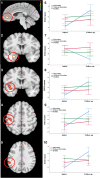Neural Responses to Fluoxetine in Youths with Disruptive Behavior and Trauma Exposure: A Pilot Study
- PMID: 34076503
- PMCID: PMC8575058
- DOI: 10.1089/cap.2020.0174
Neural Responses to Fluoxetine in Youths with Disruptive Behavior and Trauma Exposure: A Pilot Study
Abstract
Objective: A preliminary investigation of the impact of a serotonergic agent (fluoxetine) on symptom profile and neural response in youths with disruptive behavior disorders (DBDs) and a history of trauma exposure. Methods: There were three participant groups: (i) Youths with DBDs and trauma exposure who received fluoxetine treatment for 8 weeks (n = 11); (ii) A matched group of youths with DBDs and trauma exposure who received routine regular follow-up in an outpatient clinic (n = 10); and (iii) Typically developing youths (n = 18). All participants conducted an expression processing functional magnetic resonance imaging task twice, 8 weeks apart: (pretreatment and post-treatment for youths with DBDs). Results: Youths with DBDs and trauma exposure who received fluoxetine treatment compared to the other two groups showed: (i) significant improvement in externalizing, oppositional defiant disorder, irritability, anxiety-depression, and trauma-related symptoms; (ii) as a function of fearful expression intensity, significantly decreased amygdala response and increased recruitment of regions implicated in top-down attention control (insula cortex, inferior parietal lobule, and postcentral gyrus) and emotional regulation (ventromedial prefrontal cortex [vmPFC]); and (iii) correlation between DBD/irritability symptom improvement and increased activation of top-down attention control areas (inferior parietal lobule, insula cortex, and postcentral gyrus) and an emotion regulation area (vmPFC). Conclusions: This study provides preliminary evidence that a serotonergic agent (fluoxetine) can reduce disruptive behavior and mood symptoms in youths with DBDs and trauma exposure and that this may be mediated by enhanced activation of top-down attention control and emotion regulation areas (inferior parietal lobule, insula cortex, and vmPFC).
Keywords: disruptive behavior disorder; fluoxetine; insula; trauma; ventromedial prefrontal cortex.
Conflict of interest statement
No competing financial interests exist.
Figures


Similar articles
-
Dual neurocircuitry dysfunctions in disruptive behavior disorders: emotional responding and response inhibition.Psychol Med. 2016 May;46(7):1485-96. doi: 10.1017/S0033291716000118. Epub 2016 Feb 15. Psychol Med. 2016. PMID: 26875722 Free PMC article.
-
Neural Correlates of the Propensity for Retaliatory Behavior in Youths With Disruptive Behavior Disorders.Am J Psychiatry. 2016 Mar 1;173(3):282-90. doi: 10.1176/appi.ajp.2015.15020250. Epub 2015 Oct 6. Am J Psychiatry. 2016. PMID: 26441155 Free PMC article. Clinical Trial.
-
Reward Processing in Children With Disruptive Behavior Disorders and Callous-Unemotional Traits in the ABCD Study.Am J Psychiatry. 2021 Apr 1;178(4):333-342. doi: 10.1176/appi.ajp.2020.19101092. Epub 2020 Jul 31. Am J Psychiatry. 2021. PMID: 32731811 Free PMC article.
-
Cortical and Subcortical Gray Matter Volume in Youths With Conduct Problems: A Meta-analysis.JAMA Psychiatry. 2016 Jan;73(1):64-72. doi: 10.1001/jamapsychiatry.2015.2423. JAMA Psychiatry. 2016. PMID: 26650724 Review.
-
Risperidone in the management of disruptive behavior disorders.J Child Adolesc Psychopharmacol. 2006 Aug;16(4):379-92. doi: 10.1089/cap.2006.16.379. J Child Adolesc Psychopharmacol. 2006. PMID: 16958564 Review.
Cited by
-
Neural Responses to Intranasal Oxytocin in Youths With Severe Irritability.Am J Psychiatry. 2024 Apr 1;181(4):291-298. doi: 10.1176/appi.ajp.20230174. Epub 2024 Feb 29. Am J Psychiatry. 2024. PMID: 38419495 Free PMC article. Clinical Trial.
-
The contribution of childhood trauma to irritability symptoms.JCPP Adv. 2024 Jul 1;5(1):e12260. doi: 10.1002/jcv2.12260. eCollection 2025 Mar. JCPP Adv. 2024. PMID: 40059990 Free PMC article.
-
Callous-Unemotional Traits Moderate the Relationship Between Irritability and Threatening Responding.Front Psychiatry. 2021 Nov 16;12:617052. doi: 10.3389/fpsyt.2021.617052. eCollection 2021. Front Psychiatry. 2021. PMID: 34867494 Free PMC article.
References
-
- Achenbach TM: Manual for the Child Behavior Checklist/4–18 and 1991 Profile. Burlington, Vermont: University of Vermont; 1997.
-
- American Psychiatric Association. Diagnostic and Statistical Manual of Mental Disorders, 5th ed. Washington, DC: American Psychiatric Association; 2013.
-
- Andrewes DG, Jenkins LM: The role of the amygdala and the ventromedial prefrontal cortex in emotional regulation: Implications for post-traumatic stress disorder. Neuropsychol Rev 29:220–243, 2019. - PubMed
-
- Balia C, Carucci S, Coghill D, Zuddas A: The pharmacological treatment of aggression in children and adolescents with conduct disorder. Do callous—unemotional traits modulate the efficacy of medication? Neurosci Biobehav Rev 91:218–238, 2018. - PubMed
MeSH terms
Substances
Grants and funding
LinkOut - more resources
Full Text Sources
